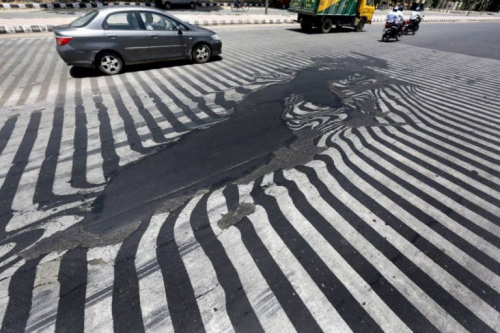The cause of unusual heat in Asia
El Nino along with climate change due to human factors is the cause of abnormal hot weather this year.
Why is it so hot in Asia?
"In the Indian capital, it is expected that the heat will continue for 4 more days. The temperature in Pakistan is up to 50 degrees Celsius, and the heat waves from there to India ," IB Times quoted BK Yadav, director of Indian Meteorological Center.

Asphalt in New Delhi flows because of the hot sun.(Photo: EPA)
Temperatures are increasing in central, northwest, east and south India, with temperatures sometimes reaching 47 degrees Celsius. In hilly areas, temperatures are similar. The scorching sun melted plastic on a large road in the capital New Delhi, causing white lines to turn black.
The number of people dying from the hot sun all over India exceeded 1,100. This is the record heat wave in the past three decades , with a temperature of 5 degrees higher than the average heat.
The city of Hyderabad in southern India only has five hot days every year, however, in the future, it is expected that the number of hot days will be up to 40 days , according to the Climate Change Research of Hyderabad Research Institute. climate Potsdam, Germany.
Causes and influences
Experts say that El Nino is the cause of Pacific ocean temperature warming, causing hot weather throughout Asia. El Nino is a phenomenon that dramatically changes sea surface temperature in the tropical belt of the Pacific Ocean, which occurs every 2-7 years when trade winds (strong winds blow continuously from southeast or northeast) on equatorial direction) begins to weaken. El Nino causes temperatures to rise, causing storms, floods and dryness.
"In the past few hundred years, temperatures have risen to about 0.8 degrees, people will suffer more heat waves, even if they don't happen El Nino. El Nino increases the air temperature and therefore , causing more trouble for global warming, "said J Srinivasan, president of the Center for Climate Change at the Indian Institute of Science.
The series of 22 studies " Explaining the extreme phenomena in 2013 from a climate perspective" clearly points out that the hot sunshine waves in 2013 were human-induced climate change.
Global warming due to human factors makes 2014 the hottest year recorded, this trend will continue in 2015 due to El Nino coming soon, predicted by the National Oceanic and Atmospheric Administration (NOAA). ) America.
The average global concentration of carbon dioxide (CO2) in the atmosphere exceeds the alarm level, at 400 parts per million (ppm) in March 2015. The average growth rate of atmospheric CO2 concentration in the period 2012-2014 is 2.25 ppm per year. CO2 is a powerful greenhouse gas that causes global warming. The concentration of CO2 in the atmosphere is constantly increasing mainly because people burn fossil fuels, industrial and agricultural waste.
The oceans of the world are absorbing C02, causing the pH of the sea water to change and become more acidic, causing many negative impacts on the world's aquatic resources.
- The cause of unusual heat waves and recent forest fires
- Why is Hanoi and North and Central hot and hot?
- Unusual heat in the Egyptian pyramid
- All Asia struggles to deal with the terrible heat
- El Nino brings hot sun from Asia to Europe
- Climate change - 'culprit' causes wildfires and unusual heat
- Unusual summer alerts in the tropics
- The number of deaths due to hot weather in Europe increased sharply
- Unusual weather in Germany, at least 6 people were killed
- Unusual hot sun in cold Alaska
- Predict the hot sun record in 2014
- Why unusual weather?
 Is the magnetic North Pole shift dangerous to humanity?
Is the magnetic North Pole shift dangerous to humanity? Washington legalizes the recycling of human bodies into fertilizer
Washington legalizes the recycling of human bodies into fertilizer Lightning stone - the mysterious guest
Lightning stone - the mysterious guest Stunned by the mysterious sunset, strange appearance
Stunned by the mysterious sunset, strange appearance